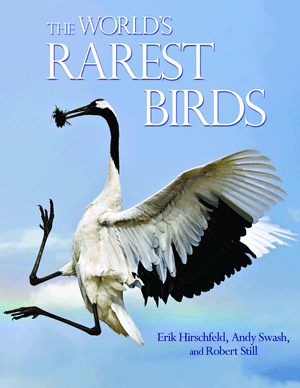 This book is actually about threatened birds rather than rare birds – it deals with those 197 species which are regarded as Critically Endangered and those 389 which are Endangered.
This book is actually about threatened birds rather than rare birds – it deals with those 197 species which are regarded as Critically Endangered and those 389 which are Endangered.
Having said that, many of these species are very rare. For example, there are (or were) 27 Sulu Hornbills in the world (on three islands in the Philippines). The forests where this species used to be more numerous have been felled for rubber and oil palm plantations – so, don’t worry, even if the bird goes extinct you can remember it every time you buy a new car tyre or fill up with fuel (with that dash of biofuel in it).
But not all the species are rare. The Indian Vulture still numbers 45,000 – it’s just that not very long ago there were over 1 million of them. And there are over a million Black-browed Albatrosses but there won’t be anything like that many in a few decades time if predation by introduced cats and deaths from long-line hooks continue to take their toll.
This is a bit of a depressing book – because of its focus on threatened species. I kept coming across species and thinking ‘Ooh! I’ve never heard of that. How pretty!’ and then realising the the species was on the brink of extinction.
Many of the species in this book may not exist in 50 years time. That’s a sobering thought – or actually one that might make you reach for a stiff drink. Although, you may be surprised to find that ‘only’ 130 avian species have been driven to extinction since 1500 (including, of course, the Dodo, Passenger Pigeon, Great Auk). We have the knack of just realising that we are going to do something awful and sometimes stopping just in time. But that means there are a lot of species limping through the world in hugely-depleted numbers.
13 bird species have become extinct in my lifetime and there are some famous species which aren’t yet officially accepted as extinct eg Ivory-billed Woodpecker, Slender-billed Curlew, Eskimo Curlew. I wonder who has the longest list of ‘birds seen in the wild that are now extinct’. Any offers?
You can draw your own conclusions from reading this book. If I were giving advice to a bird species I would suggest it didn’t want to be flightless, live on a small island (or even a big one in Hawaii) or on top of a few mountain tops. It shouldn’t be an albatross or vulture or parrot, and it should watch its step if it is a pigeon too. But the lesson for us is that we are carelessly and wantonly reducing the natural beauty of the world through over-consumption leading to habitat destruction and through unregulated trade leading to damaging introductions.
This is an excellent book; packed with information, well-designed, full of excellent photographs and with lots of well-written and interesting text. The photographs are marvellous. And the illustrations of those birds for which no decent photographs exist, by Tomasz Cofta, are excellent too.
It is a book that is a joy to have – but a shame that it needs to exist.
The World’s Rarest Birds is published by Princeton University Press and is available on Amazon, as is Mark Avery’s Fighting for Birds.
[registration_form]
Sounds like a book that I’ll actually buy, for me books like this are fascinating as it can (probably not in this book though) show the problems facing/proving a species is either endangered or indeed gone and trying to deal with the all typical human emotion that we can’t be the reason why these birds and other species are wiped off the face of the earth…mind you some birds etc once thought “gone” aren’t like the kakapo etc.
…sorry I forgot to add, are any Britsih birds featured in the book?
None of the birds included breed in Britain, but the Endangered Velvet Scoter and Critically Endangered Balearic Shearwater are featured. The book covers species that are globally Critically Endangered or Endangered, with Data Deficient birds listed in the appendix. It does not include Vulnerable species – if it had stretched to them as well, Long-tailed Duck would have entered the list. It’s worth remembering that the UK (like the US) is unusual in not using internationally recognised (IUCN) threat criteria, but has it’s own system for assessing species of conservation concern.
If variety is the spice of life – which I’d argue is the case then these threatened birds are all worth saving. Or are they? Realistically many will go extinct, mostly due to indifference, apathy and greed. Not just from politicians or greedy developers but all of us. Conservation is expensive but time is priceless. I think we already spend too much energy looking at endangered species to save, and should be concentrating on saving ecosystems while we can. Governments around the world have for generations put green issues on the backburner. They only understand ‘big ideas’ so let’s talk up a really big one. Buying the rainforests.